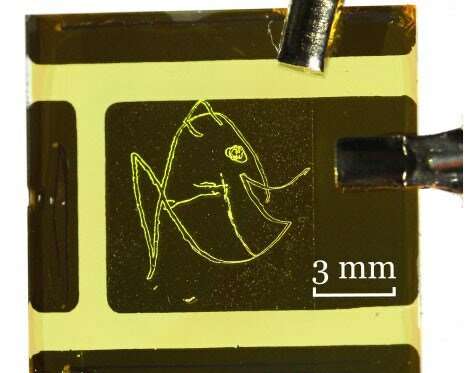New possibilities for light-emitting plastics with patterned light

Light-emitting plastics are used today in television and smartphone displays, light-emitting indicators and as illumination for cars and aircraft with special demands. The knowledge about how light is created and affected within the light sources is, however, comparatively limited.
In his thesis, Ph. D. candidate Mattias Lindh, who has studied the operation of light-emitting electrochemical cells, shows that the precise thickness of a film of light-emitting plastics is decisive for how bright and efficient the light sources will be. Reflections within the light sources give rise to interference—that is, light waves that interact with each other and can enhance or decrease the intensity, This interference is affected by the thickness of the film. To develop bright, efficient devices, the film's thickness should be controlled to optimize a system in which the light waves interfere constructively.
"The unique light sources we work with, which have the complicated name 'light-emitting electrochemical cells,' are very well suited to fulfill these criteria, and at the same time, the fabrication can be cost-effective and environmentally friendly," says Lindh, a student at the Department of Physics at Umeå University.
But there are also other loss channels in the light sources, and computer simulations can reveal these loss channels. From the simulation results, Lindh has suggested a number of ways to design future optimized light sources that deliver maximum brightness with high efficiency. "For example, it is possible to change the order of the films, or change the flatness of the interfaces between them in ways that affect the reflections of the light," he says.
Lindh also studied how light-emitting electrochemical cells operate at a microscopic level, and even created light-emitting patterns by putting layering two thin plastic films. The first layer can be printed with an inkjet printer and form a kind of display with high resolution and adaptable patterns. This technique could replace complex, expensive methods used today.
Another possibility is to scratch one of the films with a sharp stylus like a needle or a mechanical pencil, which results in manually formed and personalized light-emitting patterns. This technique could be used to produce light-emitting signatures or marks that would be very difficult to forge for authentication of valuable or secured documents and products.
"In addition to the scientific publications, my colleagues and I are also pleased to have been able to submit a patent application related to our findings on patterned light emission. It is an exciting process, but it is a lot of work writing a patent application," says Lindh. Future applications for the plastic light sources include light-emitting bandages to improve wound healing or activating drugs locally, or light-emitting security features in passports and similar valuable documents.
More information: On the operation of light-emitting electrochemical cells. Umeå University, Faculty of Science and Technology, Department of Physics. umu.diva-portal.org/smash/record.jsf?pid=diva2%3A1285763&dswid=-2254
Provided by Umea University




















